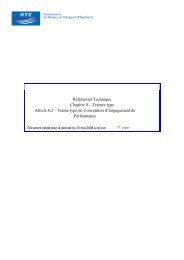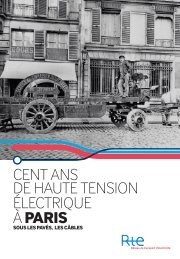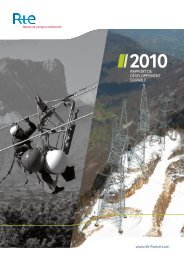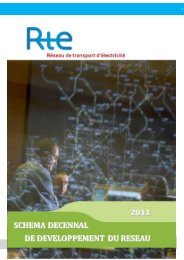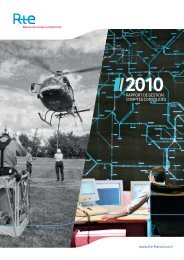Power System Reliability Report - RTE
Power System Reliability Report - RTE
Power System Reliability Report - RTE
- No tags were found...
You also want an ePaper? Increase the reach of your titles
YUMPU automatically turns print PDFs into web optimized ePapers that Google loves.
R-AUDIT-SG-DAR-MAS-11-2011/022010 <strong>Reliability</strong> <strong>Report</strong>Page : 33/408 juillet 2011addition, amongst the level A and higher incidents, and if we set aside high voltage overruns on the400 kV network declared mainly by Elia, which hardly affect system reliability, the potentially worryingevents are: two losses of the main power-frequency regulator by a TSO and 11 non-concomitantlosses of observability of the 400 kV network by different TSOs, for levels (scope and duration) moreor less serious.6.2 Feedback other than ESS<strong>RTE</strong> teams perform reliability-related feedback analyses that are not limited to ESS occurrences, on aregional as well as a national level, particularly in the context of the CNREX and the TransmissionTechnical Committee. Different annual technical reports – telecontrol, line and substation equipment,and protections – are drawn up and examined by these committees to monitor underlying evolutions.Thus, following the infection of different industrial systems worldwide by the "Stuxnett" virus, ananalysis looking at the vulnerability of <strong>RTE</strong>‟s digital instrumentation and control methods was carriedout. The CNREX approved the conclusions reached: though this virus did not infect the equipment,other relatively harmless viruses were found in different installations, but the regions were notaffected; the measures set up therefore seem to protect the equipment properly if they are strictlyapplied. They were strengthened nevertheless and regular awareness raising actions are required.The CNREX also examined the learnings from the flood on 15 th June in the Var. Confronted with awater level much higher that the 100-year flood level, the 225 and 63 kV Trans substations werebadly damaged, but the recent 400 kV substation was not harmed, in accordance with therequirements established for construction 25 . The preparations for the event announced by the weatherforecast meant that the right decisions could be made, in particular for load shedding conditions toavoid the propagation of the incident to a wider electrical zone than the one affected. The efficiencywith which the crisis was managed should be highlighted. In terms of corrective actions, apart fromthe upgrading of the damaged substations with a higher level of protection, preventive actions in caseof future flooding on a regional level have been undertaken: updated inventory of the vulnerability ofthe region‟s substations, analysis of the possibilities of "bridging" the 400 kV links, so as to be able tobypass flooded substations and thus reduce the risk of spreading the incident to the whole regionalnetwork.For all the 380 lines at 400 kV, the rate of unscheduled outage was 0.06 % (0.08 % in 2009) and therate of scheduled outage for work was 2.16 % (1.97 %). Amongst the 400 kV lines, there are 181“sensitive” ones in these 400 kV facilities, whose unscheduled absence in real time leads to significantproblems for the electrical system and for which <strong>RTE</strong> implemented specific measures (improvedmaintenance sets, quick-reaction equipment inspections even out of working hours in the event of atrip, etc.); their unscheduled outage rate stood at 0.04 %. Also to be noted are 67 "strategic" 400 kVlinks whose absence in operation causes inconvenience such that measures are required to reduce theneed to shut them off for maintenance purposes; the unscheduled unavailability rate was 1.47 %(1.67 %).These results are among the best annual ones for sensitive links and reasonable considering the lastten years for strategic links. They are clearly better than the results observed for the links overall,which is to be expected but has not always been the case. These results are by nature quite variableaccording to network incidents (small number of lightning strikes in 2010) and the type of work tocarry out for scheduled outages.Moreover, contractual commitments between <strong>RTE</strong> and the producer EDF regarding reliability aremonitored by a specific committee. The main themes examined were the methods of dealing with theunit reactive power limitations, the monitoring of actions taken on one side or the other following anincident, application of the contract on network restoration and voltage recovery.25 Within the scope of the Flood Risk Prevention PlanCopyright <strong>RTE</strong>. This document is the property of <strong>RTE</strong>. Any communication, reproduction, publication even partial is forbidden without the express written authorisationElectricity Transmission <strong>System</strong> operator (<strong>RTE</strong>)






